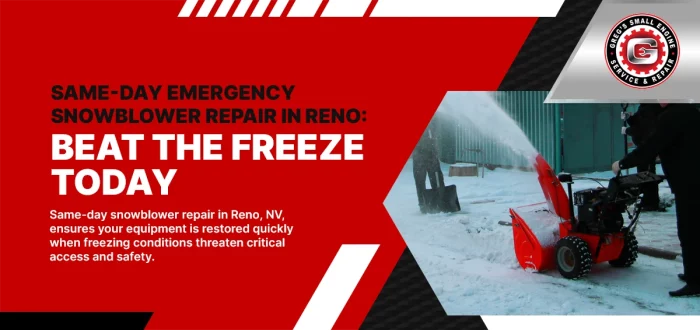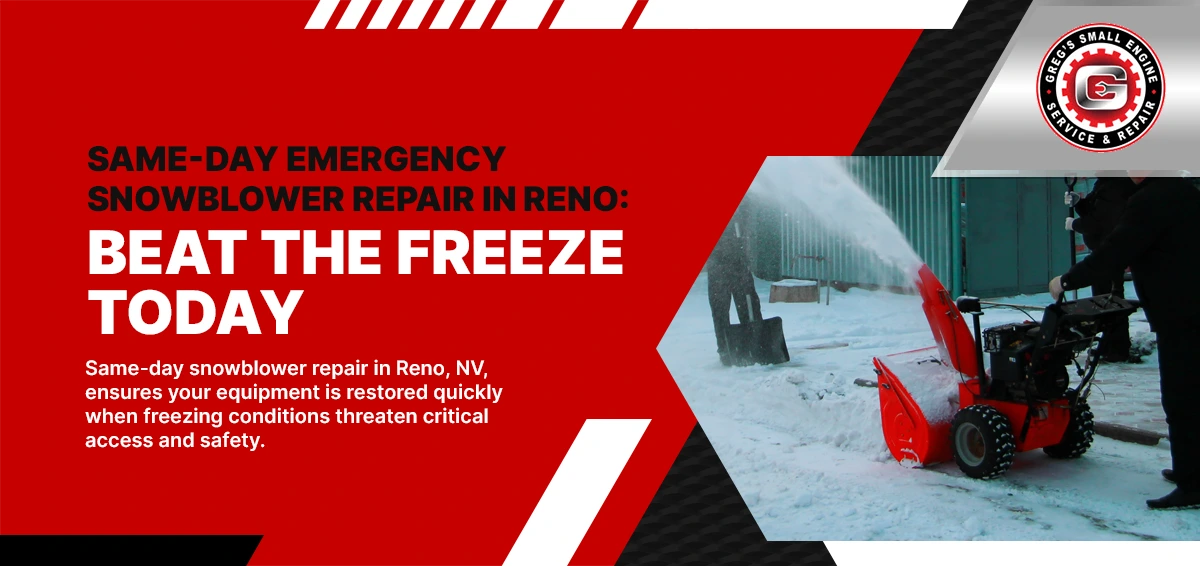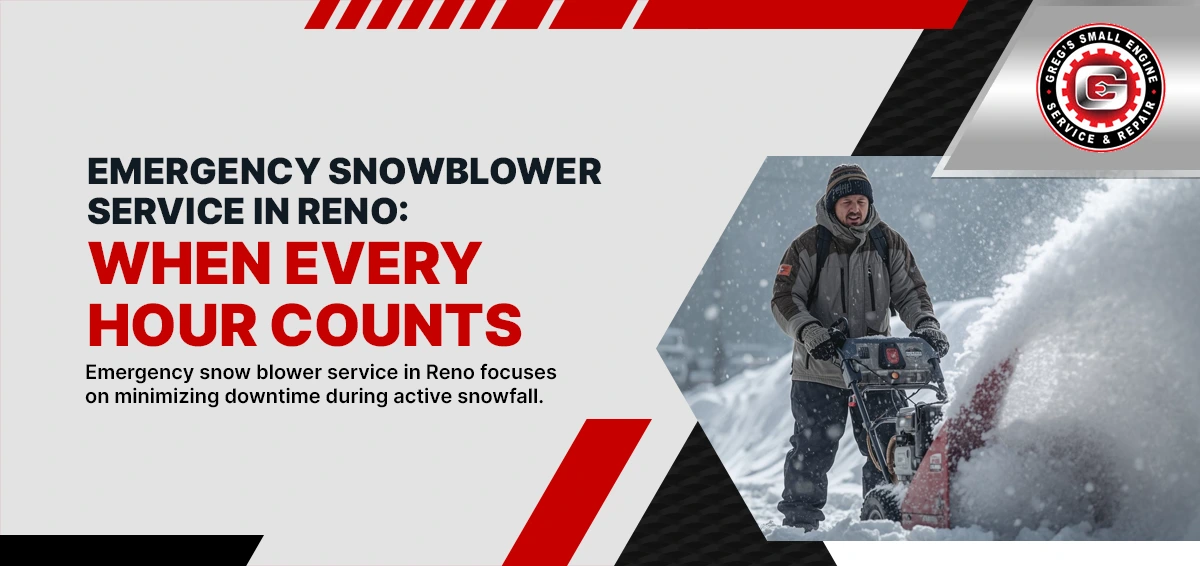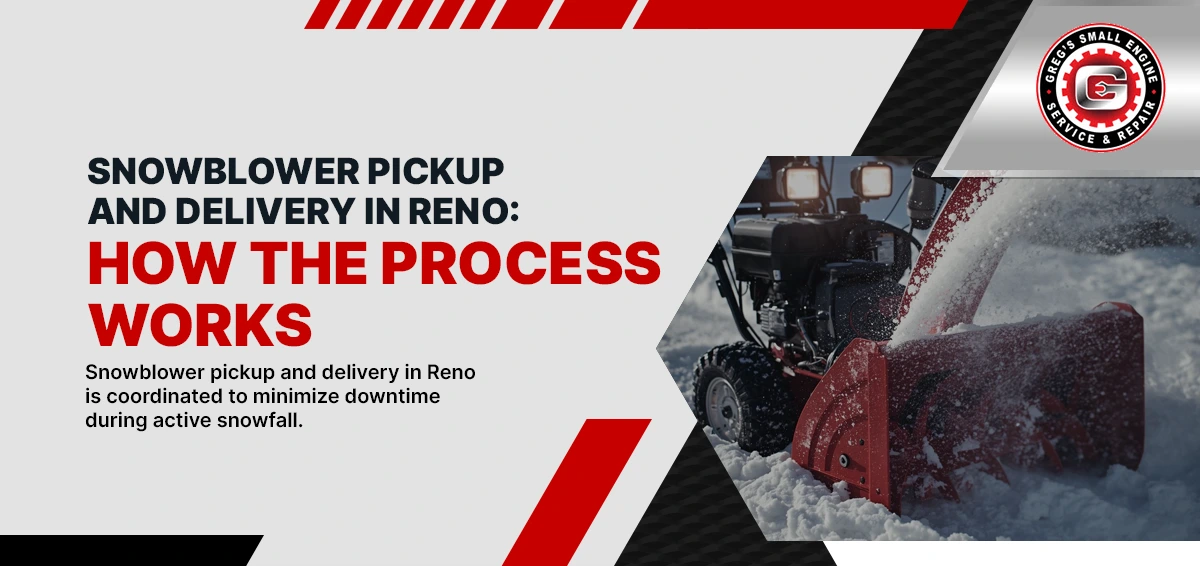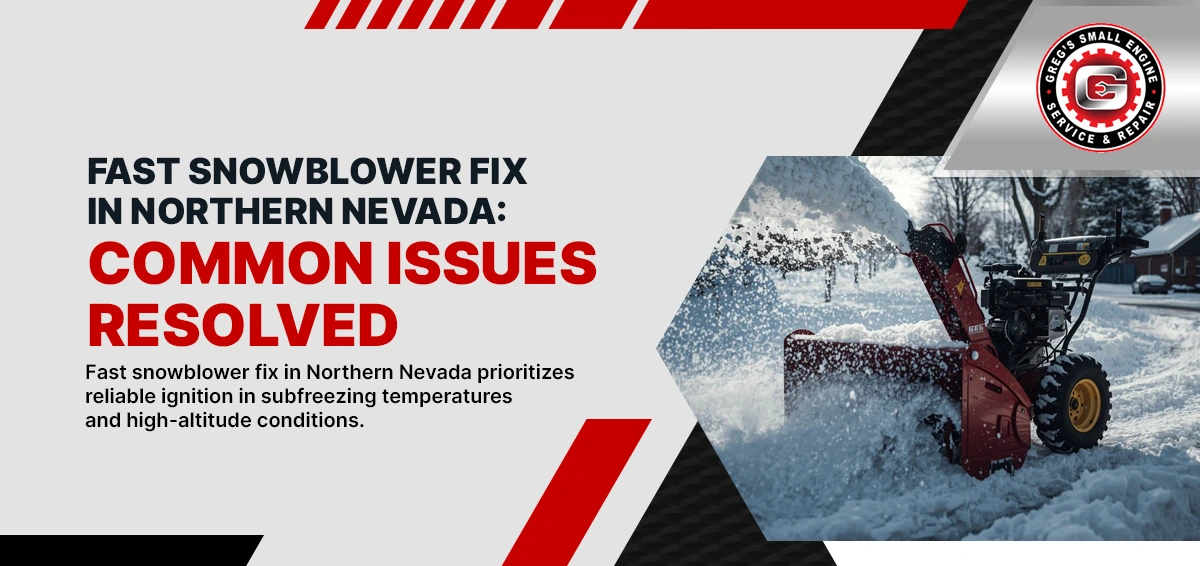Same-Day Emergency Snowblower Repair in Reno: Beat the Freeze Today
Same-day snowblower repair in Reno, NV, ensures your equipment is restored quickly when freezing conditions threaten critical access and safety. Our emergency service prioritizes rapid diagnostics, available OEM parts, and trained technicians to reduce downtime during peak snowfall. We service single-stage and two-stage models across major brands, resolving hard starts, clogged augers, belt failures, shear pin breaks, and fuel system issues.
Transparent estimates, defined timelines, and quality-tested repairs support reliable low-temperature performance. With options for expedited scheduling and local pick-up and delivery, this service helps homeowners and property managers keep driveways and walkways clear, even on the same day, when conditions change.
Emergency Snow Blower Service in Reno: When Every Hour Counts
Emergency snow blower service in Reno focuses on minimizing downtime during active snowfall. Service requests are triaged immediately, and eligible jobs are assigned to the next available technician with a targeted same-day response window. Communication includes confirmation of model and symptoms, estimated arrival, and preliminary parts planning to accelerate repair once on-site or in-shop.
Prioritization and Triage
Safety-critical and access-critical failures receive priority. Typical high-priority cases include:
- Auger or impeller not turning due to belt failure or sheared pins
- Hard start/no start in subfreezing conditions
- Drive system failures are preventing traction or steering
- Chute rotation/deflector faults that halt clearing progress
Lower-risk concerns are scheduled after essential access is restored.
Technician Readiness
Technicians are trained on single-stage and two-stage units across leading brands, including Ariens, Toro, Honda, Husqvarna, and Cub Cadet. Cold-weather procedures guide diagnostics, torque specs, lubricant selections, and post-repair testing. Everyday consumables—belts, shear pins, cables, spark plugs, fuel line, and carburetor components—are stocked to expedite same-day completion when possible.
Diagnostic Workflow
A structured workflow shortens time to fix:
- Verify the complaint and perform a quick safety inspection
- Cold-start and fuel-system assessment (spark, compression, fuel quality, carburetion)
- Drive, auger, and impeller system checks (belts, tensioners, pulleys, gearbox)
- Electrical review (switches, interlocks) and control cable adjustments
- Functional test under load and final tune
Parts and Contingencies
If an uncommon component is required, the technician provides a documented estimate, lead time, and alternatives when available. Where appropriate, temporary measures (e.g., belt substitution within spec) may be offered to restore operation until the exact part arrives.
What to Expect During Peak Events
Response Windows: Adjusted for storm intensity and road conditions, with clear updates if routes change.
- Service Location: On-site repairs are prioritized for straightforward issues; complex repairs may move in-shop for faster turnaround.
- Quality Assurance: All completed repairs include function testing and recommendations to reduce repeat failures in low temperatures.
A reliable, fast snowblower fix depends on disciplined triage, trained technicians, and parts readiness. This approach restores safe access to driveways and walkways during severe weather with minimal interruption.
Snowblower Pickup and Delivery in Reno: How the Process Works
Snowblower pickup and delivery in Reno is coordinated to minimize downtime during active snowfall. Requests are booked by address and urgency, with same-day or next-day windows when capacity allows. Scheduling includes confirmation of machine make, model, and symptoms to determine whether immediate triage or in-shop repair is required. Customers receive a time window, driver name, and curbside instructions to ensure safe, efficient handoff.
Curbside Handoff and Documentation
Pickup is contact-efficient and documented. The driver verifies ownership, records operational status, photographs cosmetic condition, and tags all accessories (keys, covers, spare parts). A digital intake form summarizes reported issues and transport notes. Machines are drained or secured as needed to prevent leaks, then loaded using ramps and anchored with multi-point tie-downs.
Transport Standards and Liability
Transport follows equipment-safe protocols: low-angle loading, wheel chocks, soft straps at manufacturer-approved points, and weather protection when required. Each unit is bar-coded for chain-of-custody tracking from curbside to workbench. Liability coverage applies during handling and transport per documented intake; customers receive a copy of the intake record for reference.
In-Shop Intake and Turnaround
After arrival, the service team performs a multi-point inspection and confirms parts availability. Straightforward issues—such as shear pins, belts, cables, plugs, and minor carburetion—are prioritized for same-day completion when inventory is on hand. If special-order components are necessary, the estimate includes lead time and an optional interim solution when safe and appropriate.
Delivery Back to Your Location
Upon completion, the machine is test-run under load, chute and drive functions are verified, and fasteners and cable tensions are rechecked. Delivery is scheduled to the original address or an alternate approved site. The driver reviews the work performed, leaves a copy of the service report, and provides post-repair operating notes for cold-weather reliability.
How to Prepare for Pickup
- Clear a path to the machine and remove debris or ice hazards.
- Provide model and serial numbers and note recent symptoms.
- Remove personal items; secure loose accessories in a labeled bag.
- Ensure reasonable fuel level or disclose fuel condition (fresh vs. stale).
This process enables predictable logistics, documented custody, and efficient repair flow for customers in Reno, Sparks, and nearby communities during severe weather.
Fast Snowblower Fix in Northern Nevada: Common Issues Resolved
Fast snowblower fix in Northern Nevada prioritizes reliable ignition in subfreezing temperatures and high-altitude conditions. Typical root causes include stale or ethanol-degraded fuel, fouled plugs, restricted jets, weak spark, and incorrect choke use. Service includes fuel replacement, carburetor cleaning or rebuild, plug and filter renewal, valve-lash verification on applicable engines, and cold-weather start calibration.
Loss of Auger or Impeller Power
When the machine fails to move snow, technicians inspect the belt train, tensioners, pulleys, and shear pins. Common resolutions include:
- Replace worn or broken auger/impeller belts
- Install new shear pins and verify hub alignment
- Adjust belt tension and idler geometry to factory spec
- Inspect gearbox lubricant level and seals for load integrity
Drive System Failures
Traction loss on inclines or packed snow is frequently tied to friction-disc wear, drive belt glazing, chain tension, or axle key issues. Corrective actions cover friction-wheel replacement, drive belt service, chain alignment, differential/axle inspection, and calibration of speed selector linkages for smooth engagement.
Clogging and Poor Throw Distance
Heavy, wet snow common to regional storms can overwhelm underserviced machines. Restorative steps include chute and housing de-icing, scraper-bar and skid-shoe adjustment, impeller and auger clearance checks, and baffle alignment. Carburetion and governor tuning restore RPM under load, improving discharge distance and clearing rate.
Chute, Deflector, and Control Faults
Chute rotation or deflector failures typically result from cable stretch, frozen pivots, stripped gears, or motor faults on powered systems. Service addresses cable replacement and tensioning, lubrication of pivot points, gear/rotation ring repairs, deflector hinge service, and electrical diagnostics for switch or motor continuity.
Vibration, Noise, and Premature Wear
Persistent vibration indicates bent auger flights, damaged bearings, misaligned pulleys, or loose fasteners. The remedy includes bearing replacement, pulley truing, hardware re-torque to spec, and dynamic run-testing. Skid shoes and scraper bars are reset to protect surfaces while preserving intake height for uneven drives.
Fuel and Cold-Weather Optimization
Technicians provide winter-grade fuel guidance, ethanol mitigation, and storage best practices to stabilize performance between storms. Recommended measures include fuel stabilizer use, correct oil viscosity, battery charging protocols for electric start, and end-of-storm inspection notes to prevent repeat failures during the next system.
Preventive Maintenance to Avoid Mid-Storm Breakdowns
Conduct a full mechanical inspection before the first snowfall. Confirm auger and impeller alignment, check gearbox oil level and seals, and inspect belts for glazing or cracks. Verify the friction-disc condition on drive systems. Re-torque fasteners to specification, confirm chute rotation and deflector range, and examine scraper bar and skid shoes for even wear. Replace worn parts to restore design clearances.
Fuel and Lubrication Readiness
Drain off-season fuel and refill with fresh, winter-grade fuel; add stabilizer to mitigate ethanol-related varnish. Replace the spark plug and thoroughly inspect the air filter; clean or replace as required. Change engine oil to the viscosity recommended for cold starts (often 5W-30 or synthetic equivalent). Lubricate pivot points, cables, and chute rings with cold-rated lubricant to prevent freeze-up.
Wear Parts and Critical Adjustments
Set belt tension and idler geometry to factory specification. Replace brittle auger/impeller belts and keep labeled spares on hand. Install new shear pins if any show deformation, and verify the correct grade. Adjust scraper bar and skid shoes to match surface conditions, protecting pavers while maintaining intake height for uneven drives. On single-stage units, inspect rubber paddles and replace if the wear indicator is reached.
Cold-Weather Starting Reliability
Confirm battery health on electric-start models and maintain charge between storms. Perform a cold-start test: verify choke operation, primer function, and governed RPM under load. Clean carburetor jets or install a service kit if hesitation or hunting occurs. Inspect ignition switches and safety interlocks for consistent continuity. Record baseline performance to identify deviations quickly during events.
Between-Storm Care and Storage
After each use, clear packed snow and ice from the housing, chute, and controls. Inspect for belt dust, loose hardware, or fluid seepage. Top off fuel, wipe down exposed metal, and store indoors or under a breathable cover to reduce condensation. Document new noises, vibrations, or drift so the next inspection can target developing faults.
Spares and Tools Kit
Maintain an at-home kit with:
- Auger and drive belts, correct shear pins/bolts, and cotter pins
- Spark plug, fresh fuel stabilizer, and cold-rated lubricant
- Cable ends, a small hardware assortment, and a basic wrench set
- User manual with torque specs and part numbers
Consistent preventive maintenance reduces failure risk during peak snowfall and preserves clearing performance throughout the season.
Conclusion
A reliable snowblower is essential for safe access during active storms, and timely service prevents minor issues from becoming costly failures. Same-day diagnostics, stocked wear parts, and trained technicians support rapid restoration of auger, drive, fuel, and control systems across leading models. Documented pickup and delivery streamline logistics, while post-repair testing and clear operating guidance strengthen cold-weather performance. Preventive maintenance—proper fuel management, belt and shear pin readiness, and confirmed adjustments—further reduces the risk of mid-storm downtime for homes and small commercial sites throughout Reno and surrounding communities.
Schedule same-day service now: call 775-790-0435 or contact us at https://gregsmallengine.com/contact-us/.

